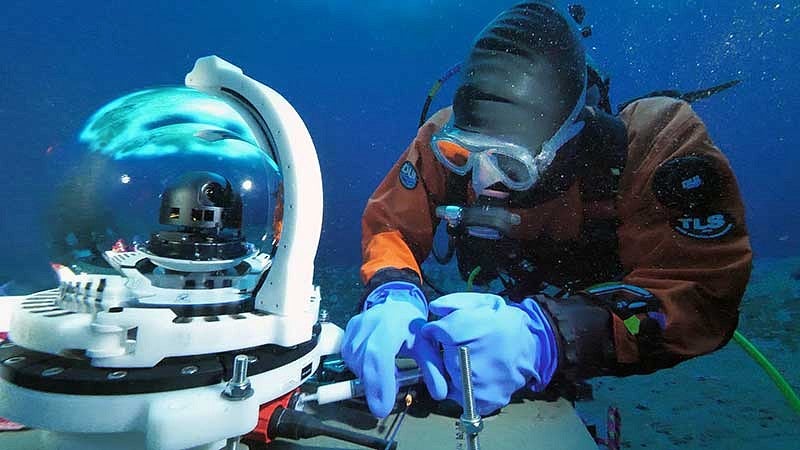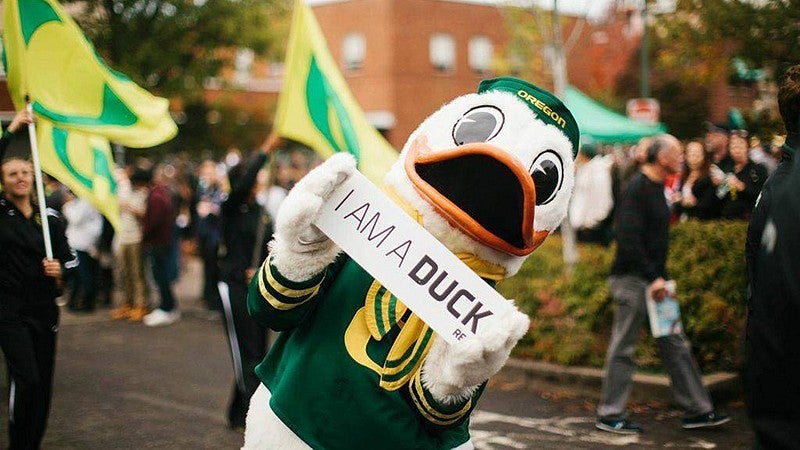What a year it’s been for the University of Oregon.
We said goodbye to the Class of 2018, and welcomed the Class of 2022. We opened new and renovated halls, and broke ground on new buildings and a new science campus. We said goodbye to our most venerable athletics venue — and looked forward to its world-class replacement.
Our researchers also broke new ground, reporting on exciting developments in the worlds of earth sciences, astrophysics, marine biology, paleontology, prevention science and more.
Our student-athletes excelled once again, thrilling us with deep runs in post-season competition.
We welcomed new campus leaders and new academic stars.
We celebrated bountiful gifts from generous donors and neared an ambitious, unprecedented fund-raising campaign goal — and decided to keep on going.
Without further ado, here’s a look back at some of the most noteworthy stories of 2018 at the University of Oregon.

Building blocks:
In March, campus officials broke ground on the $1 billion Phil and Penny Knight Campus for Accelerating Scientific Impact. The first phase of the project is set to open in early 2020. In September, we welcomed scientist and entrepreneur Robert E. Guldberg as the campus’s executive director.
In April, it was announced that century-old Hayward Field would be demolished and replaced with a new, bigger stadium in time to host the 2021 World Track and Field Championships. The old stadium, beloved by fans and athletes around the globe, had been the scene of six Olympic Trials, 20 world records and innumerable thrills. The new stadium, funded with private gifts, will have room for 12,500 fans, expandable to nearly 30,000 for Worlds, and provide world-class training and competition grounds as well as research facilities to study the potential of human performance.
Construction continued apace on several new campus buildings, including Willie and Donald Tykeson Hall, a $39 million project that will integrate both academic and career advising as well provide new classroom space. In addition, campus officials broke ground in October on a new $2.5 million Black Cultural Center.
In November, a campus planning group recommended moving the historic Collier House to Gerlinger Green to make room for a new, centrally located classroom and faculty office building. The $10.5 million renovation of Chapman Hall, meanwhile, received a DuMuro Award, an accolade for historic preservation.
The College of Education received a $32.6 million grant that allows it to continue its work helping teach students with disabilities. The grant is believed to the largest ever awarded to the UO.

Discoveries: In the lab, in the field
Sea pickles are here to stay. Also known as pyrosomes, these tubular colonial jellies first showed up on Pacific Northwest shores in 2014 and now appear to be settling in for the long haul, according to research by UO marine biologist Kelly Sutherland and her graduate student Hilarie Sorensen.
A Southern Oregon trail dating to the Ice Age may have been a byway used by families of mammoths, research by UO paleontologist Greg Retallack and others suggests.
In 2015, physicists for the first time detected gravitational waves from a collision of black holes in deep space, a discovery that was awarded the Nobel Prize in physics. Now gravitational waves are so commonly detected, scientists — including 11 UO co-authors — are releasing entire catalogs of them.
Supercomputer modeling, led by a UO doctoral student in the Department of Earth Sciences, is bringing into focus the volatile geology under Yellowstone National Park.
UO-led research put the lie to the notion that teen-agers are all gas and no brakes. While a subset of teens — those with weak cognitive control — engage in impulsive behavior, most teens have the ability to control impulsive and risky behaviors, a study found.
UO biologist Paul Cziko installed a video camera, microphone and ocean sensors 70 feet under the Antarctic sea ice, opening an eye onto a weird and rarely seen world.

Inspirations and celebrations
The number of Stamps Scholarship recipients doubled in 2018 from five to 10, with four going to Oregon students and six to out-of-state students. The prestigious scholarship program covers tuition, fees and other academic expenses over the course of four years.
Last spring, admitted students got a unique view of life at the UO through a virtual-reality experience known UO 360. Paired with a set of Duck’s-eye-view goggles, the UO 360 app put students on the back of a Harley-Davidson as it roared into Autzen Stadium, let them soar over campus and allowed them to virtually visit labs and classrooms and engage in nearly 100 other campus experiences.
More than 5,000 graduates were celebrated at our 142nd commencement ceremony under sunny June skies. Commencement speaker Miguel McKelvey, a 1999 grad and co-founder and chief culture officer of WeWork, told the class of ‘18: “The easy path is always going to be easy. The hard path is where you expand yourself and become a greater version of yourself.”
President Michael Schill launched Wings: UO Presidential Speaker Series, an evening of curated talks and a musical performance highlighting the research, innovation and creativity of UO professors. The inaugural Wings event took place in January, the second in June, the third in November, all at the University of Oregon in Portland.
We always look forward to the start of a new school year and Week of Welcome, the action-packed series of events that welcomes a new flock of Ducks to campus and life at the UO.
In September, we marked 10 years of PathwayOregon, a scholarship program for low-income Oregonians. As one Pathway student said: “I’m going to college. It’s going to work out.”
We celebrated LatinX culture at the UO with the UO Patos community, working to spread greater awareness of its shared cultures, traditions and future vision.
During Black History Month in February, we explored the past, present and future of black student life on campus.
Life as a journalism student means learning by doing. It means wearing more than one hat, sometimes at the same time. It means choosing your own adventure.
We were moved by first-generation college student Jared Acosta-King’s journey from being a homeless teen to a doctoral student in psychology.
Inspired by the iconic fire lookouts of the Pacific Northwest, UO interior architecture student Jess Kokkeler designed a lookout tower used by African park rangers to foil wildlife poachers.

On screen, on view
The 2018 Academy Awards brought glory for two Oregon alums. Filmmaker James Ivory, a 1951 grad, took home the Oscar for best adapted screenplay for the film “Call Me By Your Name,” his first Oscar in an individual category after a celebrated career as a director, producer and writer. At 89, he is the oldest person to win an Academy Award in a competitive category.
Jake Swantko, Class of 2011, meanwhile, served as the cinematographer on “Icarus,” an exposé of the Russian doping machine, which was awarded the Oscar for best documentary feature.
As “Animal House” turned 40, we examined how the raunchy frat house comedy filmed on our campus has aged and whether its brand of politically incorrect humor still resonates with today’s students.
Ray Atkeson, dubbed the “dean of Northwest nature photography,” captured iconic photos of snow-covered Cascade peaks, Oregon beaches and old Portland during a career that spanned more than 60 years. Thanks to a gift from his stepson, the Ray Atkeson Photography Collection — more than a quarter-million images — are housed in the UO Libraries’ Special Collections and University Archives.
The hit Netflix documentary series “Wild Wild Country” revisited the stranger-than-fiction Rajneeshpuram experiment in Eastern Oregon from the 1980s. We explored the many UO connections to the story, including a definitive collection of historical documents and artifacts related to the controversial commune held by UO Libraries’ Special Collections and University Archives.

Ducks give, and give some more
In September, as we neared a $2 billion fund-raising goal, President Michael Schill announced the university would extend the campaign by adding $1 billion. “The UO enjoys incredible upward, positive momentum,” he said. “We want to harness this energy and raise the resources that will enable us to be among the very best institutions of higher learning in the nation.”
A $10 million gift from the Robert J. DeArmond Trust, announced in June, will accelerate research that improves lives as well as the state’s economy. The gift will provide a permanent research fund in the form of an endowment for the executive director of the Knight Campus. The gift also will support efforts to recruit outstanding senior faculty members to the science campus and accelerate research at the intersection of bioengineering, neuroengineering and medicine.
New endowed faculty chairs were established at the Lundquist College of Business, the School of Music and Dance, and the College of Arts and Sciences. Each chair was funded by a $1 million gift, which in turn was matched by $1 million from the Presidential Fund for Excellence. Six more chairs are to be funded.
For the third year in a row, the DucksGive annual giving day raised more than $1 million in 24 hours of giving. This year, nearly 2,000 donors pitched in.

Wide world of sports
Women’s basketball won 33 games, claimed the Pac-12 conference title and advanced to the Elite Eight of the NCAA Tournament for the second year a row. Men’s basketball, meanwhile, made their 11th appearance in the National Invitation Tournament, losing in the second round.
On the track, the Men of Oregon won their 12th consecutive Pac-12 track and field championship, while the women finished as conference runners-up. In cross country, Oregon women finished third at the NCAA championships and the men were 15th.
The Oregon softball team won the Pac-12 Conference title for the fifth time in six seasons and advanced to the Women’s College World Series before falling in the quarterfinals. Coach Mike White departed after the season for the head job at Texas; Oregon named Melyssa Lombardi, a longtime assistant at Oklahoma, as the new head softball coach.
Oregon volleyball finished tied for the second in the Pac-12 and earned its eighth straight berth to the NCAA Tournament. The team upset Minnesota in a thrilling Sweet 16 match before falling to Nebraska in the Elite Eight.
Oregon football played its first regular season under new head coach Mario Cristobal, finishing 8-4 (5-4 Pac-12), including a 55-15 rout over Oregon State in the Civil War. ESPN College Gameday came to town for the 10th time — and the first time since 2014 — for the Stanford game, and Duck fans showed up in force for the proceedings. The Ducks are set to play Michigan State on New Year’s Eve in the Redbox Bowl in Levi’s Stadium in Santa Clara, California.
In golf, Norman Xiong was named winner of the Jack Nicklaus Award as the top men’s Division 1 golfer, capping the greatest individual season in program history with six outright wins and 23 rounds in the 60s.
Duck fans know Raevyn Rogers as an All-American track star during her time at the UO, but when she wasn’t running circles at Hayward Field, the bilingual Texan was busy earning two degrees.
Some of the original Men of Oregon visited campus for a track meet, and gathered around to tell stories of competing for and coaching with the legendary Bill Bowerman.
Justin Gallegos, a junior studying journalism, is an avid runner and member of the UO Running Club. He also has cerebral palsy, a condition that he refuses to let slow him down. In October, he was signed by Nike to a professional contract, making him the first professional Nike athlete with cerebral palsy. The moment was caught on video and quickly went viral.
But there’s more. For a list of the best of University of Oregon workplace news and information, check this story in Around the O.

